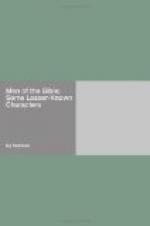altar, and table, with the seven-branched lamp stands,
of which there were ten, of beautiful construction
and ornamentation. But the most glorious work
of Hiram was the construction of the two majestic
brasen pillars, called Jachin and Boaz, They were
stately in height, the shaft of each measuring 27 feet,
a base of 12 feet, and two capitals of 13 1/2 feet,
thus the whole height of each pillar being 52 1/2
feet. The decoration was equally graceful and
elaborate, especially upon the capitals. The
lower capitals had a fine network over the whole,
and chain-work hanging in festoons outside. There
were also pomegranates wrought upon them. The
upper capitals, forming a cornice to the whole pillar,
were ornamented with lily-work. At Persepolis
there still stands a pillar, the cornice of which is
carved with three rows of lily leaves. These
pillars were esteemed the most important ornaments
in the magnificent temple, the erection of which was
the best feature of Solomon’s reign. They
were of such prominent importance that a name was
affixed to each of them. One was called “Jachin,”
which means, “he will establish,” the other
was called “Boaz,” which means “in
strength.” The ideas involved are stability
and strength. Possibly the Psalmist had these
pillars in his mind when he wrote, “
Strength
and beauty are in His sanctuary” (Ps. xcvi.
6); strength first, then beauty; strength as the foundation
of divine work, then beauty, graceful finish, and
ornament.
Hiram was an inspired artist and artificer.
He was “filled with wisdom and understanding,
and cunning to work.” We are told the
same as to the great decorative workers of the Tabernacle,
concerning whom the Lord said: “See,
I have called by name Bezalel, the son of Uri, the
son of Hur of the tribe of Judah: and I have
filled him with the spirit of God, in wisdom, in understanding,
and in knowledge, and in all manner of workmanship,
to devise cunning works, to work in gold, and in silver,
and in brass, and in cutting of stones for setting,
and in carving of wood, to work in all manner of workmanship”
(Exod. xxxi. 2-5). So also it is written of
Aholiab, Ahisamach, and other Tabernacle workers.
It is instructive to find that in Scripture, genius
as displayed in literary insight and facility, in
ingenuity and inventiveness as to the various arts,
and even in the conception of instruments of husbandry,
is attributed to Divine inspiration. It may
not be the same order of inspiration by which “men
spake from God, being moved by the Holy Ghost”;
“Searching what time or manner of time the
spirit of Christ which was in them did point unto
when it testified beforehand the sufferings of Christ
and the glories that should follow them”
(2 Peter i. 21; 1 Peter i. 11); but the fact is clear,
whether it was inspiration of a different nature or
in a different degree, that on men of special gifts
in various departments and of the highest order, wisdom




